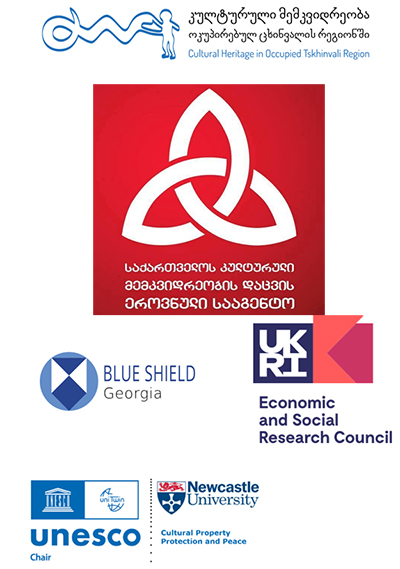Report on the Implementation of International Humanitarian Law with regards to the Protection of Cultural Heritage in the Occupied Tskhinvali Region, Georgia
3 April 2023
Introduction
On March 3, Blue Shield Georgia held the UK launch of their Report on the Implementation of International Humanitarian Law with regards to the Protection of Cultural Heritage in the Occupied Tskhinvali Region, Georgia, with Newcastle University.
The report was a collaboration between Blue Shield Georgia, the Didi Liakkhvi Valley Museum-Reserve, and the Cultural Property Protection and Peace team in the School of Arts and Cultures at Newcastle University, with a grant from the ESRC, and the QR-Policy Support Fund from Newcastle University Policy Academy.
Speakers discussed the key findings of the report, methods used, extent of damage sustained during the fighting and since; the effectiveness of cultural protection and international law before and during conflict, and during occupation; and key recommendations.

The event was opened with a keynote address by the UNESCO Chair in Cultural Property Protection and Peace, Professor Peter Stone, followed by, the authors, Manana Tevzadze, Chairman of the Georgian National Committee of Blue Shield, and Emma Cunliffe, Secretary of British Blue Shield, who spoke about the work process, the main challenges, and the main findings.
The report analysed new data from the occupied Tskhinvali region of Georgia to provide timely insights about the destruction and protection of cultural heritage across the occupied region. It is accompanied by interactive online map of the heritage sites assessed, available on the project website.
Report presentations
The event was opened with a keynote address by the UNESCO Chair in Cultural Property Protection and Peace, Professor Peter Stone.
He was followed by the authors Manana Tevzadze, Chairman of the Georgian National Committee of Blue Shield, and Emma Cunliffe, Secretary of British Blue Shield, who spoke about the work process, the main challenges, and the main findings.
The report analysed new data from the occupied Tskhinvali region of Georgia to provide timely insights about the destruction and protection of cultural heritage across the occupied region. It is accompanied by interactive online map of the heritage sites assessed, available on the project website.
The research team investigated damage in light of the primary international legislation designed to regulate the protection of cultural heritage in conflict - the 1954 Hague Convention for the Protection of Cultural Property in the Event of Armed Conflict, and its two Protocols (1954, 1999), and other key international legislation including illicit trafficking of artifacts.
Using multi-source analysis that includes eyewitness reports, interviews, media, social media, published NGO and IO reports, and satellite imagery assessment via Google Earth and published reports by UNOSAT-UNITAR, the authors demonstrated that damage was incurred not only during the hostilities in 2008, but has continued since and still continues today.
Following the fighting, other factors include illegal interventions causing alteration of the historic fabric of sites, construction of military facilities and other new infrastructure in close proximity to the sites, alongside general neglect. These pose serious risks to the preservation of the cultural heritage of the region.
The slow attrition of Georgian cultural heritage forms part of a wider narrative of loss. The lives of the people who owned and used the cultural heritage - whose ancestors may have built the sites, who visited them, who worshipped in the churches and the synagogue - are deeply impacted by the conflict in ways that move beyond their immediate needs. Not only have they lost access to their sites, but their traditions and practices and ways of living that have been passed down through generations are disrupted, and in some cases at risk of permanent loss.
The demolition of historic Georgian villages, loss of authentic fabric at sites, and modification of churches, is part of a wider revision of the entire landscape, also evidenced in the alteration of place names, and revision of historical and religious narratives.
Actions to protect and maintain heritage are hindered by lack of access; monitoring is extremely difficult. Since the early 1990s and especially in the years since 2008, given the political deadlock and lack of access, it has been - and remains - impossible for Georgia to make any progress in implementation of the 1954 Hague Convention in safeguarding and preserving its cultural property.
Based on a detailed analysis of the situation of the region’s cultural heritage, this report concludes with a series of recommendations to improve protection, covering not only the implementation of international law, but good practice.
The speakers stressed that whilst the report aims to provide the fullest picture possible, it is nevertheless incomplete. It is a first attempt to fill a gap, raise awareness on the issue and encourage wider interest and engagement in future research on the topic.
The event was attended by specialists in cultural heritage and international law, representatives of governmental, non-governmental, and research organizations, and the community interested in the topic from both the academic, museum, and cultural heritage protection fields, as well as military and civilian personnel working on cultural heritage protection from Great Britain.

